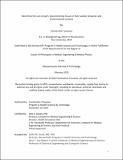More than the sum of parts: deconstructing tissues in their spatial, temporal, and environmental contexts
Author(s)
Tzouanas, Constantine
DownloadThesis PDF (43.53Mb)
Advisor
Shalek, Alexander K.
Terms of use
Metadata
Show full item recordAbstract
The human body is composed of ~37,000,000,000,000 cells, exquisitely organized into tissues delivering emergent functions beyond individual cells’ capabilities (e.g., the brain’s seemingly-effortless computations, the liver’s wide-ranging chemical processing). In my PhD, I studied how healthy tissues arise from properties and interactions of constituent cells, and how disease outcomes stem from dysregulation of underlying cellular parts. 1) To study how cells’ spatial organization shapes tissue function, I created photochemistry tools to discover gradients in how immune cells combat cancer across a tumor’s core vs. periphery. 2) To then explore spatially-structured tissues, I turned to tuberculosis (TB) granulomas: just centimeters apart, the immune system can kill bacteria in one granuloma or permit years-long bacterial survival in another. Reconciling this paradox, I discovered that bacterial killing needs coordinated signaling across immune cells, but TB-permissive granulomas structurally remodel to inhibit TB spread at the expense of “walling out” immune cells. 3) Connecting disease to lifestyle exposures, I determined tobacco smoking increases TB risk via blood-to-lung migration of TB-permissive cells. 4) Intrigued by past stresses seeding future dysfunction, I studied similar themes in adaptations to high-fat diets, discovering tradeoffs where individual liver cells promote their own survival at the expense of reduced tissue function and increased cancer risk. Through these studies, I dissected tissues and diseases with unprecedented resolution via single-cell multi-omics and mechanistic perturbations, defining the parts, interactions, and causal regulators that underlie tissue (dys)function.
Date issued
2025-02Department
Harvard-MIT Program in Health Sciences and TechnologyPublisher
Massachusetts Institute of Technology